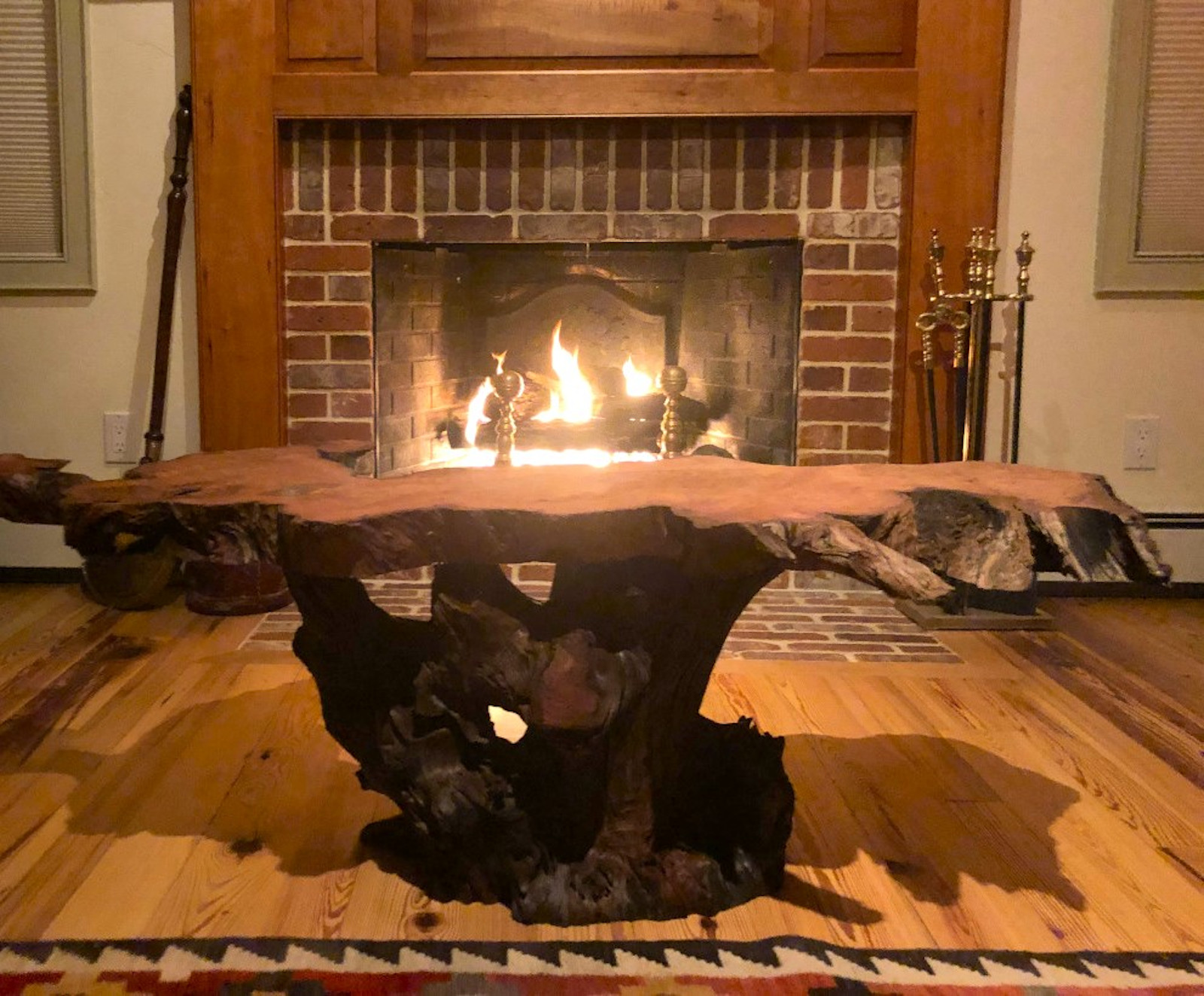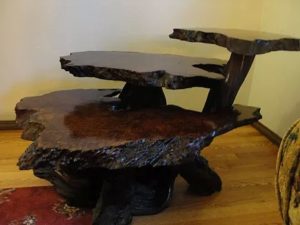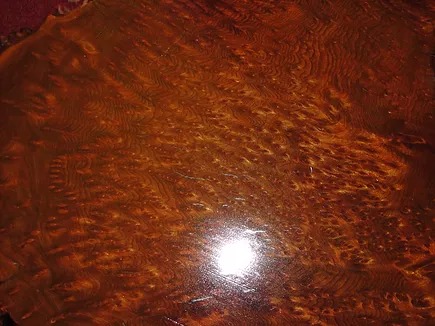
Guest Post by Adam Dias
Pricing a Vintage Redwood Burl Table
 We receive a lot of questions about pricing a vintage redwood burl table. Because of this, we feel it might be beneficial to our readers to devote an entire blog post entirely to this question.
We receive a lot of questions about pricing a vintage redwood burl table. Because of this, we feel it might be beneficial to our readers to devote an entire blog post entirely to this question.
The pictures in this blog were sent to us via our website. They are a great example of what would have been considered when it was built (and today if re-finished), a high-quality redwood burl table. That said, when I try pricing a vintage redwood table I ask a few questions. Hopefully, this helps you in determining the value of your vintage Redwood burl table.
Condition Is Key When Pricing a Vintage Redwood Table
 What condition is the table in? Most vintage tables were produced in an era of a huge boom for live edge and primitive natural furniture. For those of us in the industry that era was from about 1976 to 1989. Redwood burl was at the very top of the wave of primitive design in America. It is even said that Sears & Roebuck in the San Fransisco Bay Area carried redwood burl clocks.
What condition is the table in? Most vintage tables were produced in an era of a huge boom for live edge and primitive natural furniture. For those of us in the industry that era was from about 1976 to 1989. Redwood burl was at the very top of the wave of primitive design in America. It is even said that Sears & Roebuck in the San Fransisco Bay Area carried redwood burl clocks.
During the 70s and 80s boom, one of the most commonly used finishes was a two-part epoxy resin called Envirotex, which is basically plastic.
If your table has this on it, the cost of refinishing the table is very high. Our shop charges by the hour. When I see these pieces come into our shop, I try my best not to refinish them. It’s just too many hours of work to get that stuff off, and I feel bad charging the customer for so many hours. Envirotex is very difficult to remove.
Furthermore, if your table had a live edge before, you can expect it to have a shaped edge once it’s re-finished. Also, there are always going to be scuff marks and dings in the finish on an old vintage table. If nothing else, the finish will have started to yellow or fade. This makes for a need to refinish the table. Especially if you want to get the highest dollar. So hopefully your table has been finished with a lacquer or oil finish.
Finish is Important
The table in the pictures for this blog has a lacquered finish applied to it – at least by what I can tell from the pictures and the information I received on the table. Here is a general rule of thumb: if the finish is thick and super glossy, it’s Envirotex. Another way to tell right off is to flip the table over on its top. If it has finish drips (little bumps around the edge of the table), or you can visually see where finish drips had been sanded off, then you have Envirotex.
Quality of the Burl
 This may sound crazy, but not all pieces that are sold as burl are actually burl. Many times a simple piece of root wood is sold off as burl. It is true that it may have a live edge, may have some really nice color, and may even have some great patterns, but it isn’t a burl. This is necessary to know when you attempt pricing a vintage redwood table.
This may sound crazy, but not all pieces that are sold as burl are actually burl. Many times a simple piece of root wood is sold off as burl. It is true that it may have a live edge, may have some really nice color, and may even have some great patterns, but it isn’t a burl. This is necessary to know when you attempt pricing a vintage redwood table.
Most wood sold today is figured. This means the grain varies widely in pattern and character. When a piece has a great burl, the patterns look like bird’s eyes.
They also blur into 3D-like patterns around the wood. The more of this figure, the better the quality of the burl.
Real good burl has always been rare. Limited to pretty much the North Coast of California, Redwood burl can be very hard to get. This was even true in the 70s and 80s but is more so in today’s market. The piece pictured here has some real nice burl in it. This makes it worth more.
Pricing a Vintage Redwood Burl Table & Craftsmanship
This is a tough one. Often, the table has been built by a friend or family member or has been passed down from several generations and lands in an unsuspecting family member’s hands. Maybe it was purchased from a less than reputable dealer, and the quality doesn’t meet the price. Any way you choose to look at it, craftsmanship is key. If the table legs or base are loose if the slab is a missed cut (Meaning cut 3″ on one side and 5″ on the other). If the sanding quality is bad the top may have been warped in travel. There are a million things that separate the “ok” from the “great” pieces of functional art that sustain value over time. However, all of these factors impact pricing of a vintage redwood table.
The piece in this blog is in pretty fair condition, and, as far as I can tell, looks to be fairly well crafted. I really can’t give it too much of an assessment seeing how I can’t touch it. But I would easily give it a 6 out of 10 from the looks of the pictures. It is as much up to the seller as it is the buyer to understand quality craftsmanship. This is a tough part of an assessment, but it’s the most important part. Being that it’s old, doesn’t mean that you’ve got gold.
How are you going to sell it?
Market means everything when selling cool vintage stuff. Geography definitely plays a role in pricing a vintage redwood table. If you live in New York City and want to sell a vintage redwood burl or coffee table on craigslist, then one may expect to get a lot more than someone selling the same table in Santa Rosa Ca. The further you get away from the redwoods, the more your table becomes worth. Shipping costs alone will save you money if you live in a market that has a hard time getting redwood. That said, the internet has been upon us for some time now. Even in places where it seemed impossible to get redwood 40 years ago, one can not only get redwood, but they don’t even have to leave the comfort of their home to get it.
The best bet for marketing your vintage table is to always try your local market first. Then, try eBay, Let Go, Etsy, and so on and so on. Maybe try a local consignment store that does unique furniture, or a corky art gallery. Try to sell your piece in the location that makes the most sense. Even a yard sale can fetch a decent price on a vintage redwood burl table.
The main thing you don’t want to do is try and sell it to me. A burl broker, dealer, or furniture builder isn’t going to give you much for your piece. Mostly because they didn’t build it. Plus, they know what it costs to refinish a piece and make it their own. It’s much easier to just start with fresh wood and design your own piece than to try and re-create someone else’s.
History Is Necessary When Pricing a Vintage Redwood Table
The history of a piece is pretty important when it comes to pricing a vintage redwood table, but mostly for selling the item. It’s pretty much a given that the wood came from the Northern California Coast. But wait… Is it? No, actually it’s not. Redwood has washed up as far north as the shores of Washington state. It also grows a little in Southern Oregon and the Sierra mountain range is home to the massive Sequoia Redwood. That said, the wood to make your piece most likely came from the Northern Coast of California.
Knowing a little history, however, is pretty cool when going to sell the item. Things like: how, who, what, where, and why it was purchased are good things to know. How many owners? Who built it? What was its purpose? Where was it purchased? Why did it get purchased? Sounds simple, and it is, but vintage is cool for a reason. Not just because it looks cool, but because it takes us on a road of nostalgia-driven emotion. This is likely the reason someone will pay money for an old piece of furniture.
Final appraisal for this piece?
The piece is cool and in pretty good condition. I think it would greatly benefit from a refinishing, but the finish isn’t Envirotex, and it looks to have been well maintained. The piece is located pretty far away from the redwoods. This means that selling it locally is a pretty good option. It is definitely vintage, and it looks to be pretty well crafted too. Burl quality is very good too. I don’t know the size of the table, but it looks to be fairly good-sized. It’s a three-tier table, which limits its use a bit. Coffee tables tend to fetch a bit more.
As is: $245- $475.00
Completely re-worked and re-finished – this piece could fetch as much as $1,200.00 – $1,500.00
We hope our information on pricing a vintage redwood table helped out! If you ever decide to create your own redwood table, we would love to help you out! Contact us by phone at (707) 826-9663, or feel free to fill out our online inquiry form. We can help you ethically make the redwood table of your dreams.
Tags: burl wood, burl wood grain, Custom Burl Wood Furniture, reclaimed redwood, redwood burl, sustainable materials